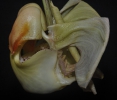|
|
|
|
|
| |
Flasks of
Coryanthes bruchmuelleri 'No. 2 - RS' × self |
|
| |
|
|
| |
| Number: |
TN8866 |
| Name: |
Coryanthes bruchmuelleri 'No. 2 - RS' × self
|
| Type: |
self (What's that?) |
|
Click to Enlarge

Pod Parent Flower |
|
|
|
| |
For additional origin/habitat information supplied courtesy of
Charles and Margaret Baker, see further below, near the bottom of this page.
|
Temperatures we attempt to use in the lab & greenhouse:
| For Species: |
|
Spring, Summer, Autumn, Winter: days average 82°F, nights 63°F; best fit is Intermediate 83-60°F
(Source:
Baker's Web OSC) |
|
About the name...
| Etymology of |
bruchmuelleri |
|
Named for A. Bruchmüller, German collector in South America in the 19th century.
(Source:
Mayr & Schmucker 1998) |
| Etymology of |
Coryanthes |
|
From Greek "korys" helmet; "anthos" flower.
(Source:
Pridgeon 1992) |
| Pronunciation of |
Coryanthes |
|
ko-ree-AN-theez
(Source:
Pridgeon 1992) |
|
If you would like to direct someone to this web page, please copy and paste this URL into your email:
http://troymeyers.com/d?018866
| Flask Information |
| Availability: |
We had yield problems with this item, so we didn't continue flasking it. |
| You should: |
Consider placing a "Notify Retries" Request, and if an identical pollination (the same parents) is done again, we'll let you know. |
| Plantlet Sizes: |
From many flasks 10 - 50 mm plants (based on flask surveys done 12/19/2019 )
From one most recently surveyed flask 10 - 50 mm (12/19/2019)
|
|
You might also want to:
|
View the seed assay for this item.
View items of the same species.
View items of the same genus.
|
|
|
| |
The origin/habitat information below is supplied courtesy of Charles and Margaret Baker
The following information is based on the name of the plant provided by the donor, and assumes that the name is correct. If the plant has been misidentified, then the following information may not be correct.
This text is copyrighted by the Bakers and may not be reproduced without permission.
ORIGIN/HABITAT: Venezuela, Brazil, and Peru. In Venezuela, plants are
found near Calderas in Barinas state at about 3000 ft. (910 m). No other
habitat details were given. Dunsterville and Garay (1966) report that this
species is also found in Brazil and Peru. In Brazil, plants grow in the
Amazonas region, but details of habitat location and elevation were not
given. In Peru, plants are found in the Department of Amazonas near
Manáos.
More about this information and the Bakers...
|
|
|
| |
|
|
|